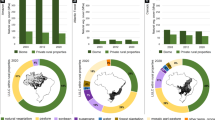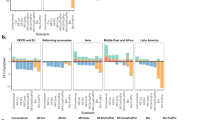Abstract
As climate change continues to threaten human and natural systems, the search for cost-effective and practical mitigation solutions is gaining momentum. Reforestation has recently been identified as a promising nature-based climate solution. Yet there are context-dependent biophysical, financial, land-use and operational constraints to reforestation that demand careful consideration. Here, we show that 121 million ha of presently degraded land in Southeast Asia, a region noted for its significant reforestation potential, are biophysically suitable for reforestation. Reforestation of this land would contribute 3.43 ± 1.29 PgCO2e yr−1 to climate mitigation through 2030. However, by taking a combination of on-the-ground financial, land use and operational constraints into account, we find that only a fraction of that mitigation potential may be achievable (0.3–18%). Such constraints are not insurmountable, but they show that careful planning and consideration are needed for effective landscape-scale reforestation.
This is a preview of subscription content, access via your institution
Access options
Access Nature and 54 other Nature Portfolio journals
Get Nature+, our best-value online-access subscription
$29.99 / 30 days
cancel any time
Subscribe to this journal
Receive 12 print issues and online access
$209.00 per year
only $17.42 per issue
Buy this article
- Purchase on Springer Link
- Instant access to full article PDF
Prices may be subject to local taxes which are calculated during checkout

Similar content being viewed by others
Data availability
Datasets used for the analyses are available from https://doi.org/10.25909/5ed71bd305a08.
Code availability
R scripts used for the analyses are available from https://doi.org/10.25909/5ed71bd305a08.
References
Tollefson, J. The hard truths of climate change—by the numbers. Nature 573, 324–327 (2019).
Rogelj, J. et al. in Special Report on Global Warming of 1.5 °C (eds Masson-Delmotte, V. et al.) Ch. 2 (IPCC, WMO, 2018).
Egli, F. & Stunzi, A. A dynamic climate finance allocation mechanism reflecting the Paris Agreement. Environ. Res. Lett. 14, 114024 (2019).
Griscom, B. W. et al. We need both natural and energy solutions to stabilize our climate. Glob. Change Biol. 25, 1889–1890 (2019).
Griscom, B. W. et al. Natural climate solutions. Proc. Natl Acad. Sci. USA 114, 11645–11650 (2017).
Smith, P. et al. Biophysical and economic limits to negative CO2 emissions. Nat. Clim. Change 6, 42–50 (2015).
Fargione, J. E. et al. Natural climate solutions for the United States. Sci. Adv. 4, eaat1869 (2018).
Bastin, J.-F. et al. The global tree restoration potential. Science 365, 76–79 (2019).
Busch, J. et al. Potential for low-cost carbon dioxide removal through tropical reforestation. Nat. Clim. Change 9, 463–466 (2019).
Luedeling, E. et al. Forest restoration: overlooked constraints. Science 366, 315 (2019).
Chazdon, R. & Brancalion, P. Restoring forests as a means to many ends. Science 365, 24–25 (2019).
Cohn, A. S. et al. Smallholder agriculture and climate change. Annu. Rev. Environ. Resour. 42, 347–375 (2017).
Lazos-Chavero, E. et al. Stakeholders and tropical reforestation: challenges, trade-offs, and strategies in dynamic environments. Biotropica 48, 900–914 (2016).
Barr, C. M. & Sayer, J. A. The political economy of reforestation and forest restoration in Asia–Pacific: critical issues for REDD. Biol. Conserv. 154, 9–19 (2012).
Wilson, K. A. et al. Optimal restoration: accounting for space, time and uncertainty. J. Appl. Ecol. 48, 715–725 (2011).
Kettle, C. J. Ecological considerations for using dipterocarps for restoration of lowland rainforest in Southeast Asia. Biodivers. Conserv. 19, 1137–1151 (2010).
Curtis, P. G., Slay, C. M., Harris, N. L., Tyukavina, A. & Hansen, M. C. Classifying drivers of global forest loss. Science 361, 1108–1111 (2018).
Estoque, R. C. et al. The future of Southeast Asia’s forests. Nat. Commun. 10, 1829 (2019).
Hengl, T. et al. Global mapping of potential natural vegetation: an assessment of machine learning algorithms for estimating land potential. PeerJ 6, e5457 (2018).
Budiharta, S. et al. Restoring degraded tropical forests for carbon and biodiversity. Environ. Res. Lett. 9, 114020 (2014).
Oakleaf, J. R. et al. Mapping global development potential for renewable energy, fossil fuels, mining and agriculture sectors. Sci. Data 6, 101 (2019).
Lewis, S. L., Wheeler, C. E., Mitchard, E. T. A. & Koch, A. Restoring natural forests is the best way to remove atmospheric carbon. Nature 568, 25–28 (2019).
Löfqvist, S. & Ghazoul, J. Private funding is essential to leverage forest and landscape restoration at global scales. Nat. Ecol. Evol. 3, 1612–1615 (2019).
Meyfroidt, P. & Lambin, E. F. The causes of the reforestation in Vietnam. Land Use Policy 25, 182–197 (2008).
Chazdon, R. L. & Guariguata, M. R. Natural regeneration as a tool for large-scale forest restoration in the tropics: prospects and challenges. Biotropica 48, 716–730 (2016).
Chazdon, R. L. Beyond deforestation: restoring forests and ecosystem services on degraded lands. Science 320, 1458–1460 (2008).
Brancalion, P. H. S. et al. Global restoration opportunities in tropical rainforest landscapes. Sci. Adv. 5, eaav3223 (2019).
Sheil, D. et al. Forest restoration: transformative trees. Science 366, 316–317 (2019).
Delzeit, R. et al. Forest restoration: expanding agriculture. Science 366, 316–317 (2019).
Strassburg, B. B. N. et al. Strategic approaches to restoring ecosystems can triple conservation gains and halve costs. Nat. Ecol. Evol. 3, 62–70 (2019).
National Inventory Submissions 2019 (UNFCCC, 2019); https://unfccc.int/process-and-meetings/transparency-and-reporting/reporting-and-review-under-the-convention/greenhouse-gas-inventories-annex-i-parties/national-inventory-submissions-2019
Crouzeilles, R. et al. Achieving cost-effective landscape-scale forest restoration through targeted natural regeneration. Conserv. Lett. 13, e12709 (2020).
Financing Emission Reductions for the Future: State of Voluntary Carbon Markets 2019 (Forest Trends’ Ecosystem Marketplace, 2019).
Tobón, W. et al. Restoration planning to guide Aichi targets in a megadiverse country. Conserv. Biol. 31, 1086–1097 (2017).
Griggs, D. et al. Sustainable development goals for people and planet. Nature 495, 305–307 (2013).
Miettinen, J. & Liew, S. C. Degradation and development of peatlands in Peninsular Malaysia and in the islands of Sumatra and Borneo since 1990. Land Degrad. Dev. 21, 285–296 (2010).
Miettinen, J., Shi, C. & Liew, S. C. Land cover distribution in the peatlands of Peninsular Malaysia, Sumatra and Borneo in 2015 with changes since 1990. Glob. Ecol. Conserv. 6, 67–78 (2016).
Bunting, P. et al. The global mangrove watch—a new 2010 global baseline of mangrove extent. Remote Sens. 10, 1669 (2018).
Land Cover CCI Product User Guide Version 2 (ESA, 2017); http://maps.elie.ucl.ac.be/CCI/viewer/download/ESACCI-LC-Ph2-PUGv2_2.0.pdf
Graham, V., Laurance, S. G., Grech, A. & Venter, O. Spatially explicit estimates of forest carbon emissions, mitigation costs and REDD+ opportunities in Indonesia. Environ. Res. Lett. 12, 044017 (2017).
Baccini, A. et al. Estimated carbon dioxide emissions from tropical deforestation improved by carbon-density maps. Nat. Clim. Change 2, 182–185 (2012).
Avitabile, V. et al. An integrated pan-tropical biomass map using multiple reference datasets. Glob. Change Biol. 22, 1406–1420 (2016).
Worthington, T. & Spalding, M. Mangrove Restoration Potential: A Global Map Highlighting a Critical Opportunity (Univ. Cambridge, 2018); https://doi.org/10.17863/CAM.39153
Miettinen, J., Shi, C. & Liew, S. C. Deforestation rates in insular Southeast Asia between 2000 and 2010. Glob. Change Biol. 17, 2261–2270 (2011).
Miettinen, J., Shi, C. & Liew, S. C. 2015 Land cover map of Southeast Asia at 250 m spatial resolution. Remote Sens. Lett. 7, 701–710 (2016).
Friedlingstein, P., Allen, M., Canadell, J. G., Peters, G. P. & Seneviratne, S. I. Comment on ‘The global tree restoration potential’. Science 366, eaay8060 (2019).
Veldman, J. W. et al. Comment on ‘The global tree restoration potential’. Science 366, eaay7976 (2019).
Buendia, C. et al. (eds) 2019 Refinement to the 2006 IPCC Guidelines for National Greenhouse Gas Inventories Volume 4: Agriculture, Forestry and Other Land Use (IPCC, 2019).
Fritz, S. et al. Mapping global cropland and field size. Glob. Change Biol. 21, 1980–1992 (2015).
Requena Suarez, D. et al. Estimating aboveground net biomass change for tropical and subtropical forests: Refinement of IPCC default rates using forest plot data. Glob. Change Biol. 25, 3609–3624 (2019).
Cameron, C., Hutley, L. B., Friess, D. A. & Brown, B. High greenhouse gas emissions mitigation benefits from mangrove rehabilitation in Sulawesi, Indonesia. Ecosyst. Serv. 40, 101035 (2019).
World Development Report 2013: Jobs (World Bank, 2012).
The World Bank Annual Report 2018 (World Bank, 2018).
FAOSTAT (FAO, 2017); http://www.fao.org/faostat/en/#data
Producer Prices-Annua (FAO, 2017); http://www.fao.org/faostat/en/#data/PP
Global Agro-Ecological Zones: Suitability and Potential Yield — Agro-Climatic Yield (International Institute for Applied Systems Analysis, 2015); http://gaez.fao.org/Main.html#
Employment by Sex and Age—ILO Modelled Estimates (International Labour Organization, 2014); https://ilostat.ilo.org/data
World Development Indicators (The World Bank, 2018); http://data.worldbank.org/data-catalog/world-development-indicators
Naylor, R. L., Higgins, M. M., Edwards, R. B. & Falcon, W. P. Decentralization and the environment: assessing smallholder oil palm development in Indonesia. Ambio 48, 1195–1208 (2019).
Hewson, J., Crema, S. C., González-Roglich, M., Tabor, K. & Harvey, C. A. New 1 km resolution datasets of global and regional risks of tree cover loss. Land 8, 14 (2019).
The World Database on Protected Areas (WDPA) (UNEP-WCMC and IUCN, 2016); http://protectedplanet.net
Weiss, D. J. et al. A global map of travel time to cities to assess inequalities in accessibility in 2015. Nature 553, 333–336 (2018).
Potapov, P. et al. The last frontiers of wilderness: tracking loss of intact forest landscapes from 2000 to 2013. Sci. Adv. 3, e1600821 (2017).
Page, S. E. et al. Review of Peat Surface Greenhouse Gas Emissions from Oil Palm Plantations in Southeast Asia White Paper No. 15 (International Council on Clean Transportation, 2011).
Reijnders, L. & Huijbregts, M. A. J. Palm oil and the emission of carbon-based greenhouse gases. J. Clean. Prod. 16, 477–482 (2008).
Saragi-Sasmito, M. F., Murdiyarso, D., June, T. & Sasmito, S. D. Carbon stocks, emissions, and aboveground productivity in restored secondary tropical peat swamp forests. Mitig. Adapt. Strateg. Glob. Change 24, 521–533 (2019).
R v.3.6.0 (R Foundation for Statistical Computing, 2019).
Hijmans, R. J. et al. raster: Geographic data analysis and modeling. R package v.2.5-8.
QGIS Geographic Information System Version 2.14 (Open Source Geospatial Foundation Project, 2019); http://qgis.org
Acknowledgements
Z.Y. and L.R.C. acknowledge support from the National Research Foundation (NRF) Singapore under its Commonwealth Research Fellowship grant (NRF-CSC-ICFC2017–05). L.P.K. is supported by the NRF Singapore under its NRF Returning Singaporean Scientists Scheme (NRF-RSS2019-007). T.W. was supported by the International Climate Initiative (IKI) funded by The German Federal Ministry for the Environment, Nature Conservation and Nuclear Safety (BMU) on the basis of a decision adopted by the German Bundestag and an anonymous gift to The Nature Conservancy.
Author information
Authors and Affiliations
Contributions
All authors contributed to the manuscript writing. L.P.K. conceived the study. Z.Y. and T.V.S. conducted the analyses and initial evaluation of results. All authors contributed discussions and modelling insights. T.W., P.T. and D.A.F. contributed key mangrove datasets, and Z.Y. and L.R.C. contributed key terrestrial and peat-swamp datasets.
Corresponding authors
Ethics declarations
Competing interests
The authors declare no competing interests.
Additional information
Reviewer recognition Nature Climate Change thanks Robin Chazdon and the other, anonymous, reviewer(s) for their contribution to the peer review of this work.
Publisher’s note Springer Nature remains neutral with regard to jurisdictional claims in published maps and institutional affiliations.
Supplementary information
Supplementary Information
Supplementary References, Tables 1–5 and Figs. 1–8.
Rights and permissions
About this article
Cite this article
Zeng, Y., Sarira, T.V., Carrasco, L.R. et al. Economic and social constraints on reforestation for climate mitigation in Southeast Asia. Nat. Clim. Chang. 10, 842–844 (2020). https://doi.org/10.1038/s41558-020-0856-3
Received:
Accepted:
Published:
Issue Date:
DOI: https://doi.org/10.1038/s41558-020-0856-3
This article is cited by
-
The neglected role of abandoned cropland in supporting both food security and climate change mitigation
Nature Communications (2023)
-
Co-benefits of forest carbon projects in Southeast Asia
Nature Sustainability (2022)
-
Tropical forest restoration under future climate change
Nature Climate Change (2022)
-
Climate impact chains for envisaging climate risks, vulnerabilities, and adaptation issues
Regional Environmental Change (2022)
-
Carbon prospecting in tropical forests for climate change mitigation
Nature Communications (2021)



